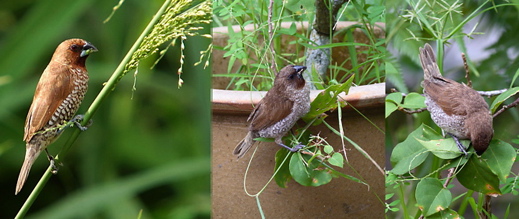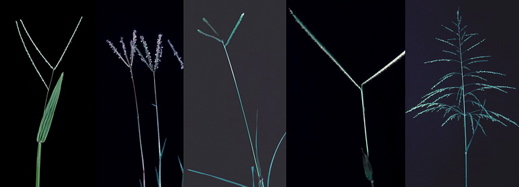In January 2006 I had an exciting encounter with a family of Scaly-breasted Munias (Lonchura punctulata) visiting my neighbour’s well-maintained garden. They came quietly and by chance I noticed them foraging among the grassy weeds. Then again, in September 2007 I had another excounter. This time, in my unkempt, weedy garden, foraging grass seeds.
The birds worked fast, pulling the grass inflorescence growing in my potted plants and stuffing the seeds in their bills. They worked from the ground, perching from the stunted bougainvillea plants growing from the pots as well as from the edge of the pots. They moved about rapidly, working different plants as they went about their foraging expedition. Then they were gone.
Obviously, munias are seed eaters. I looked up the limited literature and found that they go for the smaller grasses, like carpet grass (Axonopus compressus), Bermuda grass (Cynodon dactylon), goose grass (Eleusine indica), buffalo grass (Paspalum conjugatum) and panic grass (Panicum spp.) (above, from left to right). I am sure they take seeds of other grasses as well, but to birders, well, grass is grass. So we await more detailed observations from those who are more inclined towards plants, especially grasses. Or photographers, from whose images botanists can try identify the grasses.
In the images at the top of the page, the one on the left, taken by KC Tsang, shows a munia perched on a stalk of a ?panic grass while the other two images show the bird eating the seeds of carpet grass.
The birds also eat seeds of sedges (Cyperaceae) that some birders call grasses (Gramineae), but let’s not split hairs, and herbs like common snakeweed (Stachytarpheta indica).
Wells (2007) reports that the bird also “exploits the cones of casuarinas, often high in the crown of mature trees… also takes quantities of the nutrient-rich filamentous alga Spirogyra, found in open, wet places on paddyland etc.”
The images above (left) show a sprig of casuarina (Casuarina equisetifolia) with a close-up of a fruit that is still unripe. On ripening the many sharp projecting points will split to expose the seeds. The top right image shows a single filament of Spirogyra, also known as water silk and mermaid’s tresses, while the bottom image is an enlarged view of three filaments. The green spirals within the filaments are the chloroplasts, thus the generic name, Spirogyra. This is a microscopic green alga that grows in relatively unpolluted, stagnant or slow-moving freshwater (drains, ponds), forming masses of slimy, green, unbranched threads.
YC Wee
Singapore
October 2007
Images: KC Tsang (munia, top of page, left) and YC (others).
References:
1. Wee, Y. C. & R. Corlett (1986). The city and the forest: plant life in urban Singapore. Singapore University Press.
2. Wells, D.R. (2007). The birds of the Thai-Malay Peninsular. Vol. II, Passerines. Christopher Helm, London.












8 Responses
Hi,
Every year a pair of scaly breasted munia make their nest in my balconey amidts the potted plants. This year too, I found two such nests and I am excited to see them. Every year crows eat the eggs by tearing the nest. This year I’ve protected the nests with small pots on all sides (leaving proper place only for the munias to enter). I always wondered about their food. ALthough I’ve read in your article about the grasses or cones and spyrogyra they eat, I would still like to know if they eat any seeds we have at home or if any such food is available in the shops. Before rainy season started, I kept 2 earthen (drinking water) pots between the planted pots so that birds can make their nests but they are not yet occupied by any. I also feed the common sparrows who visit my balcony daily. Other birds like common myna, bulbul and sunbirds are the daily visitors.It’s wonderful to see them. Thanks for the information on your site. Hope to get a reply soon.
Munias eat millet which is readily available from pet shops in Singapore at about $3 per kg. However, during the breeding season, many seed-eating birds also incorporate a fair amount of animal protein into their diet. For birds like munias, aviculturalists supply this in the form of hard-boiled egg yolk (just a little will do, remember that munias are tiny birds). They will also forage from a steep-sided bowl with mealworms crawling in chicken feed. But you will have to protect such a container from ants by placing it in a tray of water. And it will be constantly raided by other birds larger than munias. Remember to change the water frequently as the fine for mosquito breeding is very heavy in Singapore.
And, hopefully, you are doing all this within the confines of your own (Non-HDB) home because the authorities take a very dim view of feeding birds in public in this country.
Hi.
Years since most recent comment, but I am hoping to learn the answer to my question about Munias. Do they eat nyjer/thistle seed?
Thank you.